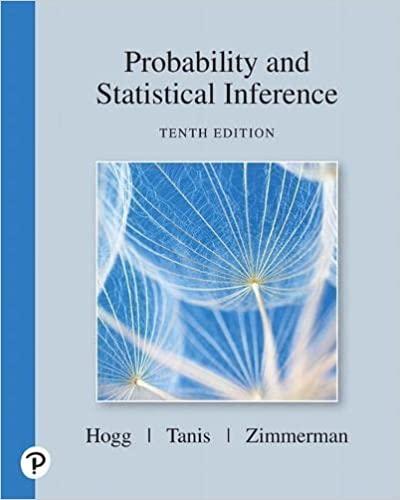Question
Rats in a Maze A researcher has collected some data on the amount of time in seconds (to the nearest 0.1 second) that it took
Rats in a Maze A researcher has collected some data on the amount of time in seconds (to the nearest 0.1 second) that it took 36 trained rats to run through a maze. The data is shown below arranged in a frequency distribution of grouped scores.
Class Interval Frequency 7.6-7.9 3 7.2-7.5 1 6.8-7.1 6 6.4-6.7 6 6.0-6.3 3 5.6-5.9 4 5.2-5.5 5 4.8-5.1 4 4.4-4.7 1 4.0-4.3 3 10. Refer to Rats in a Maze. The real limits of the interval 6.4-6.7 are _________.
a. 6.3-6.8
b. 6.4-6.7
c. 6.35-6.75
d. 6.45-6.75
e. 6.395-6.405
11. Refer to Rats in a Maze. The relative frequency for the interval 5.2-5.5 is _________.
a. 0.03
b. 0.14
c. 0.11
d. 13
e. 3.05
12. Refer to Rats in a Maze. The cumulative frequency for the interval 5.6-5.9 is _________.
a. 17
b. 13
c. 20
d. 23
e. 28
13. Refer to Rats in a Maze. The cumulative percentage for the interval 5.2-5.5 is _________.
a. 77.78%
b. 47.22%
c. 22.22%
d. 36.11%
e. 13.89%
14. Refer to Rats in a Maze: Draw the frequency histogram for this data. (4 marks) Psyc 2F23 section 02/03 name __________________ id _________ page 5 *15. Consider the following stem and leaf diagram 4|0 1 1 2 2 3 4 4 4 4|5 5 6 6 6 6 7 7 7 8 9 9 5|2 2 2 3 3 4 4 5|5 7 8 9 9 6|0 1 2 3 6|5 9 7|0 1 7|6 What is the median score? _______ (1 mark) What is the range? _________ (1 mark) What one or two words best describe this distribution? (1 mark) ___________________ What is the lower real limit of the highest interval? (1 mark) _________ How would a histogram of this data differ from what is presented? (ONLY use space provided) (1 mark)
*16. Consider the following sample of scores. 21, 23, 24, 25, 24, 26, 24, 23, 21, 27. s = 1.9322 X2 = 5698 X = 238 What is the variance? (2 marks) What would (X-) equal ____________? (1 mark) Would (X-23.8)2 be bigger, smaller, the same as SS? (circle one, 1 mark) Why? (only use 3 or 4 words, symbols or numbers in your answer) _______________________________________________________(1 mark)
17. I am interested in how patients respond to two types of hip replacement surgery. I take 40 consecutive cases of people with broken hips admitted to a local hospital and randomly assign two groups of 20 to either the standard replacement surgery (major operation, large amounts of tissues cut), or a new technique involving a small incision, micro tools, and optic cables to repair the hip. After 6 months of rehabilitation an occupational therapist gives each person a score out of 100 assessing their overall mobility, flexibility and strength. Please identify the following a) The population(s) ___________________________ (1 mark) b) The sample(s)_______________________________ (1 mark) c) The independent variable(s)________________________________ (1 mark) d) The dependent variable(s) __________________________________ (1 mark) e) Was this an experiment or study? _________________________ (1 mark) f) Justify your answer___________________________________________________ (1 mark) g) What type of scale is the independent variable_________________________________ (1 mark) h) Justify your answer_______________________________________________ (1 mark) Psyc 2F23 section 02/03 Test 1 name __________________ id _________ page 7
18. The following data represents the mean weight of 72 wild newborn Moose (in Kg). Class Interval f Cumf Cum% 15-17 3 3 4.17 18-20 ___ 8 _____ 21-23 6 14 19.44 24-26 9 23 31.94 27-29 11 34 47.22 30-32 13 47 65.28 33-35 12 59 81.94 36-38 9 ___ 94.44 39-41 3 71 _____ 42-44 ___ ___ 100 a) Fill in the missing values (3 marks) b) A zoologist claims that moose born in captivity typically weigh more than those born in the wild. If a moose born in your zoo weighed 36.5 kg, what percentage of wild moose calves weighed more? (10 marks) c) A little known fact is that wild moose are very statically knowledgeable. A mother moose will abandon any baby moose that falls in the lowest 15% by weight. How much would a baby moose have to weigh for it to be abandoned? (10 marks) Psyc 2F23 section 02/03 Test 1 name __________________ id _________ page 8
19. You manage a large library. You want to keep wait times for patrons checking out less than 60 seconds at least 90% of the time. If the mean time to wait is 48 seconds (st dev = 6) what percentage of time will patrons have to wait longer than 60 seconds? Do you achieve your goal? (8 marks)
20.You are shopping for new tires. You buy a trade magazine that evaluates tires to help you in your decision. Unfortunately you left the magazine on the coffee table and you dog chewed it up. The information on the tires you are interested in was mostly destroyed, but you do find the following information. On one scrap of paper you find that a set of test tires lasted 156,000 km and this was listed as 1.7 standard deviations above the mean. On another piece of paper it lists the variance of tire mileage as 160,000. How long do these tires last on average? (5 marks) Ques MC 14 15 16 17 18 19 20 total perc
Step by Step Solution
There are 3 Steps involved in it
Step: 1

Get Instant Access to Expert-Tailored Solutions
See step-by-step solutions with expert insights and AI powered tools for academic success
Step: 2

Step: 3

Ace Your Homework with AI
Get the answers you need in no time with our AI-driven, step-by-step assistance
Get Started


